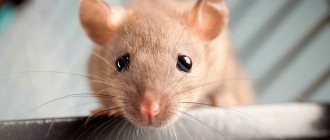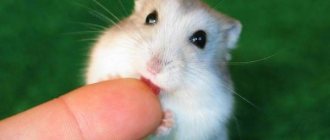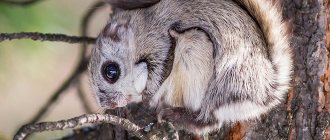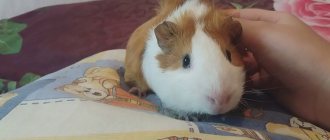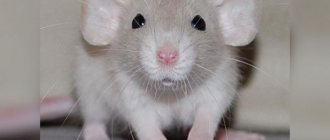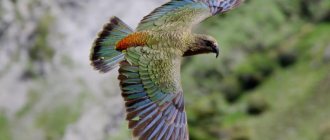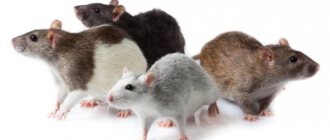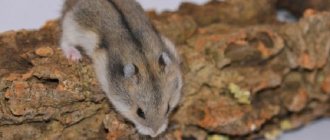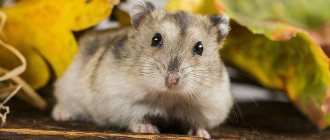Ferrets are popular pets that rarely get sick under the right conditions. However, sometimes owners are faced with the fact that their ferret's tail becomes bald. Hair loss can be caused by many factors. To solve a problem, you need to pinpoint its root cause. After this, you should decide whether to fight the disease on your own or seek help.
Causes of tail baldness in ferrets
There can be many reasons why a ferret goes bald. Some of them are physiological, others require medical intervention. Factors that provoke loss of fur on the tail of tame predators are:
- Stress . The lack of shelters and openings in the home, moving causes stress in pets, which is why they go bald.
- Pore blockage during estrus in females and rutting in males. Ferrets go bald due to clogged pores. You can determine this problem by carefully examining the skin on the tail. When the pores become clogged, the skin will be covered with dark or brown spots.
- Inappropriate coat care. In the absence of water procedures and combing of fur, animals can go bald.
- Infestation with ticks, fleas or lice.
- Vitamin deficiency - a lack of vitamins leads to the animal going bald.
- Unbalanced diet. Feeding your pet table food, sweets and forbidden foods can result in a rapidly balding ferret.
- Adrenal gland disease. Characterized by loss of fur from the end of the tail, then fur falls out on the inner thighs and beyond. The animal becomes anxious, loses appetite and goes bald.
Also, the fact that hair begins to fall out can be affected by age and childbirth. You should dwell in more detail on the molting of ferrets. Seasonal shedding in ferrets occurs twice a year and is divided into spring and autumn. The duration depends on the amount of daylight. Hair loss starts from the tail and extends to the entire fur, and then the coat is restored.
Can fleas pass to humans?
In particularly advanced situations, insects can be found throughout the home, including on humans. The insects will bite and cause an unpleasant itch, especially for those people who are sensitive to insect infestation. As a rule, bite marks appear in the leg area, primarily in the ankle area. If the bite site is scratched, a secondary infection may enter the body.
Remember, you are responsible for those you have tamed, take care of your pet, devote as much time to it as necessary! The above methods will help cure your pet or completely avoid the appearance of fleas in your home.
Infection with ectoparasites is one of the most common problems in pets. Most owners do not distinguish between these annoying insects, highlighting mainly only the flea. What are the features of these ectoparasites and what consequences will the presence of insects on the body of an animal entail? Let's consider these questions.
The ferret is going bald and itchy
If your pet begins to go bald and itch, then the following factors may be the reasons:
- Molting, during which ferrets tend to itch . This behavior is normal and not considered a cause for concern.
- Fleas or ticks. A striking symptom of the appearance of these parasites is the ferret's baldness; the animal constantly itches and tries to get rid of fleas. If lice or fleas are detected, special preparations for skin parasites are used to destroy them.
- Otodectosis . The causative agent is an ear mite, which settles in the ear canal, causing severe itching, constant scratching and partial loss of fur. An infected ferret constantly shakes its head, scratches its ears and head, and loses its appetite.
- Sarcoptic mange. The causative agent is considered to be itch mites. The disease is accompanied by unbearable itching, the skin where it is scratched turns red and swollen, then festers. Fretka is going bald, losing weight and appetite.
Pore contamination
Very often, a ferret's tail can become bald due to clogged pores. This phenomenon may be associated with the following problems:
- hormonal imbalance during hunting or pregnancy;
- low cleanliness of a particular individual.
Clogged pores are clearly visible to the naked eye: in places where the tail is bald, there are black or brown dots. When neglected, the skin may be covered with red scabs. To clean the skin of an animal, a certain series of hygiene procedures should be carried out. You should purchase a scrub for animals in specialized pet stores, but a similar product can be made at home.
The recipe for the cleanser is simple:
- almond;
- cereals;
- sour cream.
The first 2 components should be ground in a blender and then mixed with sour cream, which has a healing effect on the skin. Peeling areas need to be treated several times until the blackheads completely disappear.
A more budget-friendly option is regular laundry soap. It is diluted to a mushy state and applied to the tail with a toothbrush, gently rubbing the skin. Make sure that the soap does not have a bleaching effect, otherwise the animal’s tail can be severely burned.
What you can do on your own
When faced with the fact that a ferret is going bald for the first time, owners do not know what to do in this situation. First, you should calm down and carefully examine the animal, observe the pet’s behavior. If the animal behaves normally, does not refuse food, is still playful and affectionate, then there is no reason to worry. What kind of help should be provided to the ferret depends on the cause of baldness:
- When molting, regular brushing of the animal's fur will help speed up the process. To strengthen the immune system, ferrets are given vitamins and minerals during molting.
- If the cause is stress, then comfortable conditions are created for the pet: they take care of a secluded place and proper nutrition.
- If the pores become clogged, the owner should thoroughly wash the ferret, clearing the clogged pores. For cleansing, use laundry soap applied to the skin or a herbal scrub (grated almonds, sour cream and crushed oatmeal). The scrub is applied to clogged pores until they clear.
- When fleas or lice are detected, special preparations are used to eliminate skin parasites.
If your ferret goes bald for more than a month and new fur does not appear, you should consult a veterinarian.
How to treat insulinoma: the veterinarian's route of action
Treatment for insulinoma in a ferret depends on the stage at which the tumor was discovered and how serious the general changes in the pet’s body are. Therapy can be surgical or medicinal, but more often it is a combined method using both options. The treatment is tailored strictly to the patient, depending on the symptoms, tumor volume, impairment of vital functions, the age of the ferret and the preferences of the owner.
In fact, with insulinoma it is impossible to guarantee a 100% positive cure result. The problem is the blurred clinical picture and the difficulty of completely removing the tumor.
Surgery
It will be effective only for non-advanced cases of insulinoma. It consists of removing all visible tumors, usually there are several of them, which creates certain difficulties during resection. At the same time, the volume of the adrenal glands is checked to see if they are enlarged.
Surgical treatment relieves some symptoms and can improve the pet’s well-being, but does not guarantee a complete cure for insulinoma due to the high probability of metastasis to other tissues and organs. More often, veterinarians agree that after one operation it is advisable to maintain the normal condition of the ferret with diet therapy and medications.
Treatment with drugs
It must be carried out after surgery or used for animals with a high anesthetic risk or with other contraindications to surgery (age, concomitant diseases, etc.). Prednisolone and diazoccid are prescribed in combination with diet.
Any treats or sweets are strictly contraindicated; they can provoke hypoglycemia due to the likelihood of increased production of insulin by insulinoma cells.
The prognosis for the disease ranges from cautious to unfavorable. A timely visit by the ferret owner to a veterinary clinic, a successful combination of surgical, medicinal methods and diet will give the ferret a chance to live under constant medical supervision for 1 to 3 years
Ignoring treatment is 100% fatal.
If you notice that your pet is behaving atypically or is showing signs of illness, don’t hesitate! Call the RosVet VC by phone, 24 hours a day. Make an appointment or bring your ferret urgently for examination.
When to seek professional help
The following external signs and changes in your pet’s behavior are considered reasons to urgently seek help from a veterinarian:
- refusal to eat;
- lethargy and weakness of the ferret;
- weight loss;
- redness of the skin in areas where hair has fallen out;
- baldness of not only the tail, but also the inside of the thighs, head, paws;
- aggression;
- seals and bumps at the site of baldness;
- peeling, roughness or discharge of pus in areas of baldness;
- The ferret constantly itches, scratching her skin until it bleeds.
The above signs, including the fact that the ferret is going bald, may be symptoms of serious diseases: hyperplasia, adrenal disease, otodectosis, sarcoptic mange, scabies. These diseases require urgent medical intervention, and many of them are treated surgically.
If you do not seek help from a veterinarian, your pet will die. In addition, even if the animal gives no cause for concern, but baldness lasts more than a month, you should urgently call a doctor to examine the ferret. The sooner the cause of baldness is determined and treatment is started, the greater the chances of a successful outcome.
Once you get a pet ferret, you need to follow the rules and recommendations for caring for the animal, which will help you avoid baldness. You need to carefully monitor the behavior and well-being of your pet, and if any deviations are detected, you should accurately determine the cause of hair loss in order to take appropriate measures.
Allergic reaction
It is not smart to draw parallels between human and canine health, but animals are also susceptible to various types of allergies, including food allergies, to:
- the food consumed or its change;
- hygiene products;
- substances that enter the body through the air;
- vaccination.
A sign that the body is rejecting the food it eats is when your pet scratches its ears, entire head, paws, and even its tail. Redness or rash appears on the abdomen, groin, and armpits. This is easier to detect in short-haired dogs than in long-haired dogs. Due to the intense itching, it itches so badly that it can wear off the incisor teeth. Allergic reactions are caused by proteins (anaphylaxis) or non-protein components of food (atopy). If symptoms occur, it is necessary to carry out differential diagnosis from specialists in order to identify intolerance to individual ingredients or allergies in general. The change in diet and the course of treatment depend on this. Often allergenic foods for dogs are:
- horse meat, beef, milk;
- lamb, chicken, soy.
When changing food, the response of the pet’s body is unknown. Ready-made food is divided into categories, for example: economy or premium. It is not a fact that premium food ingredients are suitable for a dog that has been using the economy option for a certain time, and vice versa. In animals, sensitivity is much higher; some rough ingredient may be rejected.
The same preventive hygiene products against ticks sometimes provoke rejection. When your pet continues to itch after using flea drops, he may be allergic to this medicine. Sometimes various forms of dermatoses are provoked by tick collars. It is more often observed in puppies whose skin does not respond positively to insecticides. The kids itch a lot, trying to pull off the collar.
Not only is exposure to chemicals dangerous for puppies, but allergies also occur for them and are seasonal. During the spring-summer period, one- to three-year-old cubs are sometimes exposed to atopic dermatitis. This disease affects 4 to 16% of adult dogs. It is called by:
- dust, mold;
- flower pollen;
- feathers, bird fluff;
- excrement, particles of cockroaches, flies, bedbugs, mice.
This form of dermatitis is practically incurable, but it is not particularly dangerous. The main thing is not to come into contact with harmful elements. For example, keep the premises clean or do not walk the dog where there are massive flowering plants. Sometimes even experienced veterinarians are at a loss when determining the diagnosis.
If your dog is itching but there are no fleas, it may be a reaction to the vaccination. It is detected on its own. It is necessary to part the fur; if there are red drops on the skin, and the animal bites itself, then most likely the body is rejecting the vaccine. In puppies it appears on the paws, withers, muzzle, and hair loss is also observed.
Vitamin deficiency
If animals do not have the required amount of vitamin H in their bodies, hypovitaminosis develops. The result of the development of the disease is damage to the epidermis. If there is not enough biotin in the body, this is a consequence of the animal eating raw chicken proteins too often. This product interferes with the absorption of biotin by the body. The main signs of the disease are an inflammatory process on the surface of the epidermis, the development of seborrhea, alopecia and severe itching.
To get rid of the pathological process, the doctor prescribes multivitamin complexes to the animal, which contain biotin. You should also include foods with a high content of this vitamin in your diet.
Liver diseases
“Pain in the right side can occur with damage to the liver and organs of the hepatobiliary system,” notes Bulat Yunusov. “Such diseases include cholecystitis, obstructive jaundice, liver cysts, hepatitis, and cirrhosis.” All of these diagnoses are characterized by fairly sharp pain in the right side, which can “radiate” to the right shoulder, neck or shoulder blade.
Women often experience pain on the lower right side due to malfunctions of the pelvic organs. “Such work disorders include inflammatory diseases (salpingitis, salpingoophoritis) and non-inflammatory (corpus luteum cyst, ovarian tumors, endometriosis, ovarian cysts, ectopic pregnancy),” notes Bulat Yunusov.
With salpingitis (inflammation of the fallopian tubes) and salpingo-oophoritis (inflammation of the fallopian tubes and ovaries), the pain is most often felt as a pulling in the groin area, but it can also “radiate” to the right or left side. Accompanied by fever, nausea, severe headache, vaginal discharge and intensifies during sexual intercourse.
With ovarian or corpus luteum cysts, pulling or stabbing pain is mainly localized in the lower abdomen or lower back, but can also be felt in the right side.
With endometriosis, the pain is most often acute, cramping, and can disappear and return. It is felt, as a rule, in the lower abdomen, in the left or right side (closer to the lower back).
Jar of Hearts
A ferret can go bald from stress or boredom. These small predators need an active lifestyle. If you keep an animal in a locked small cage, the animal can get sick and begin to rapidly go bald. Loud noises or strong smells can also cause hair loss. Do not spray air fresheners near the animal’s cage or install a TV, stereo or radio. During renovations, the ferret should be kept in the furthest room from the renovation.
Nervous shock may be due to lack of shelter. Under natural conditions, ferrets live in steppe burrows, so the animal definitely needs to equip a small house for the night. The home should be warm and dark, with a rounded entrance. A soft bedding insulated with foam rubber is placed at the bottom of the house.
Treatment of genital itching
Treatment for this condition depends on the causes that caused it. Patients are prescribed various drugs locally and orally:
- Antibiotics and antifungals that destroy pathogens that cause the urge to scratch.
- Antipruritic drugs used for non-infectious diseases.
- Anti-inflammatory, relieving redness and other discomfort.
- Antiallergic, used for allergic manifestations.
Growths on the genitals - condylomas and papillomas - are removed using a laser. This technique does not cause bleeding, and the tissue heals quickly after it.
Life activity of parasites
If the conditions of detention are violated and there is a lack of necessary hygiene, ferret owners may encounter problems such as skin parasites in their pets. Therefore, it is very important to detect parasites on your pet’s fur in a timely manner. The most common parasites that may appear are lice, nits and fleas.
Fleas can be found much less frequently than on other pets. The main symptoms of their vital activity are severe itching, the appearance of areas without fur, scabs and papules. The development and reproduction of parasites is accompanied by anemia and slower growth of the animal.
To get rid of parasites, it is necessary to use chemicals. They must be used strictly according to the instructions if the animal’s body weight has reached 500 grams and is at least six months old. Such products should not be applied to a female who is bearing offspring. To prevent the development of parasites, it is recommended to carry out regular preventive treatment, at least once every six months.
Allergy
The ferret began to itch outside of the molting period, but there are no fleas on its body? Perhaps it's an allergy. Three main elements of a ferret’s everyday life can be a breeding ground for allergens:
- Stern. Dyes are often added to cheap food, which can be rejected by the body. This reaction causes itching and severe scratching.
- Tray fillers. Chemicals are added to the mixture so that they can effectively combat the smell of animal urine and feces. Upon contact with moisture, the chemical evaporates and gets on the animal’s skin, causing a rash and severe itching. The animal can comb the problem area until it bleeds.
- Often the allergen is detergents for frets. For this reason, all bathing practices should be reduced to a minimum.
To determine what exactly has become an allergen, eliminate one potential breeding ground for allergens at a time. Change the food - it didn’t help, the tray filler - the same result, the detergent - the animal stopped itching. This is done simply and without harm to the animal. Have you noticed that such a replacement did not give anything? It's better to contact a specialist. The veterinarian will do a couple of tests, and you will already know exactly the causes of allergic itching.
This reason cannot be called serious, unlike the next one.
Why does hair “go away”?
There are a million reasons for pathological, premature hair loss. Radiation and intoxication, frost and heat, frequent and long stays at sub-zero temperatures without headwear, the atmosphere of megacities is outside; endocrine (especially in women) and any other, including dental, diseases - from the inside. Not to mention scarring on the scalp as a result of skin diseases or a disease such as trichotillomania - a tendency to neurotically pull out one's own hair. However, temporary mechanical baldness can also be the result of completely cold-blooded actions: hairdressing procedures, for example, frequent perms or the use of low-quality hair dyes. Cause baldness and any mental trauma. Just like febrile diseases, they can cause both acute diffuse and alopecia areata. In ancient times, this disease was called “fox disease” - it was believed that where the fox marked its territory, the grass no longer grew. In this case, sudden hair loss can occur both during the most stressful situation and 6-9 months after mental trauma. But all these cavalry attacks on a person by a bald head are usually not fatal. Of course, if they are not running.
Our hair is afraid of stress
The appearance of a bald spot can cause severe psychological shock to its unlucky owner. Especially for women. They may be 4 times less prone to baldness than men, but if “it” has started for them, then the vicious circle is almost inevitable: worries about baldness intensify it. And the most advanced pharmacology may no longer help: hair is a nervous “creature” in all respects. But men, for all their apparent indifference, are not at all indifferent to premature hair loss. The only thing that changes is their reaction to “baldness” - standard wigs have been replaced by exotic comb-overs, which are increasingly being replaced by “zero” hairstyles.
Treatment of itching
Depending on why the skin itches, treatment recommendations will differ, but there are several general rules that, if followed, will help relieve the itching.
Particular attention should be paid to the rules of personal hygiene. When taking a bath or shower, do the following:
- Use cool or lukewarm water (not hot).
- Avoid using soap, shower gel or deodorant with fragrances. Fragrance-free lotions or water-based creams can be purchased at your pharmacy.
- Apply a moisturizing lotion or cream without fragrance after a bath or shower to prevent your skin from drying out.
Regarding clothing and bedding, adhere to the following rules:
- Avoid wearing clothes that irritate your skin, such as those made from wool or synthetic fabrics.
- Buy clothes made from cotton whenever possible.
- Avoid tight-fitting clothing.
- Use mild detergents that do not irritate the skin.
- Sleep in light and loose clothing.
Anti-itch medications
Regarding medications, adhere to the following rules:
- Apply a rich moisturizer to dry or flaky skin;
- If prescribed by a doctor, you can use steroid (hormonal) creams for several days, applying them to inflamed, itchy areas of the skin;
- Take antihistamines (anti-allergy medications) to stop itching - consult your doctor before use.
Antihistamine tablets can also cause severe drowsiness, so do not drive, use power tools, or do heavy work that requires alertness after taking them.
Some antidepressants, such as paroxetine or sertraline, can relieve itching (if your doctor prescribes them, it does not mean you are depressed).
Hormonal imbalance
In males, changes in hormonal levels occur during the period of sexual desire. This is accompanied by hair loss. This is observed in females when they are bearing offspring. These processes are physiological and do not require specialist intervention. After the end of these periods, the hormonal levels return to normal, the coat restores its previous condition.
During this period, the male becomes extremely agitated, aggressive and irritable. It begins to mark the territory, the production of sebum increases, as a result of which the fur becomes greasy and smells unpleasant.
The ferret becomes inactive, loses appetite and body weight, and may chew on the bars of the cage. If mating of adults does not occur, this condition in the male may continue until the onset of winter. To solve this problem, your veterinarian may recommend castration of your pet. This must be done before the first year.
Main features
The symptoms of seborrheic alopecia are similar to those of seborrhea, since both diseases are caused by a malfunction of the sebaceous glands. The main features include:
- unpleasant odor;
- rapid loss of freshness and cleanliness of hair after washing;
- thickened layer of keratinized skin;
- presence of inflammation.
Increased activity of the sebaceous glands leads to the appearance of excess oil on the skin. Sebaceous ducts and hair follicles become clogged. Horny particles accumulate on the scalp, face, and body. They stick together and form a viscous mass. This environment is good for fungal growth. The parasite becomes active, attacks the hair follicles, the hair becomes weak and begins to fall out.
There are three main types of seborrhea: dry, oily and mixed. Alopecia occurs with oily skin.
Mycosis
Mycosis of the skin develops under the influence of a fungus. The pathogen reproduces by spores and affects the hair and epidermis of animals. Next, fungal spores grow into the epidermis and spread to adjacent areas of the skin.
The basis of the parasite's nutrition is keratin, which is present in the epidermis and hair. At first, redness is visible, severe itching, baldness appears, and the animal is constantly itching.
Important! If there are abrasions or scratches on the body, the infection spreads faster.
The source of infection is a sick animal, lack of proper standards for keeping the ferret, and insufficient hygiene. The incubation period lasts about a month. Then the following signs of the development of fungal processes occur: alopecia, excessive dryness of the epidermis, severe itching and flaking.
Therapeutic measures consist of removing the affected areas of fur to stop the further development of the disease, treating the epidermis with antifungal ointments prescribed by the doctor. In advanced cases, the doctor prescribes antibacterial drugs and oral antifungals. The duration of treatment is usually one month.
Gastrointestinal problems
If you have poor digestion, then most likely, nutrients and vitamins are poorly absorbed. Accordingly, the skin and hair do not receive enough of them. Poorly digested food can even become an allergen for the body. For acne, hair loss, or other rashes on the body, Alexander Navrotsky advises to definitely examine the gastrointestinal tract and treat gastritis, colitis and other diseases. Otherwise, you will have bad skin and hair for the rest of your life.
“I recommend getting tested for Helicobacter pylori, a microorganism that causes gastritis and ulcers, even if you are not bothered by stomach pain or heartburn,” says the dermatovenerologist. — Helicobacter pylori is easily transmitted through saliva and dishes; the whole family often becomes infected with it. In the last six months alone, I have had several patients with severe acne and dermatitis of the perioral area: after a course of treatment against this microorganism, the rashes decreased or completely disappeared - both in a young girl and in a 70-year-old grandmother.
In general, infectious inflammatory processes in any organ, according to the doctor, can negatively affect the skin - in the form of a rash or hair loss, changes in nails. Often people lose hair after suffering from pneumonia or other inflammatory diseases, and after complete recovery, hair thinning stops.
Other diseases
Baldness in ferrets can occur with the development of more serious diseases. In the absence of hair, a veterinarian can determine the following diagnosis after a preliminary examination:
- insulinoma - the body itches, the animal focuses its gaze on one object, drags its paws. It is almost impossible to get rid of this disease;
- eczema – accompanied by the appearance of weeping, bare, flaky areas on the animal’s body, the disease is very difficult to treat;
- fungal pathologies - accompanied by the appearance of inflamed bald patches on the skin;
- neoplasia – neoplasms in the body of animals;
- endocrine pathologies.
Diagnosis of androgenetic alopecia
To diagnose androgenetic alopecia, the methods of survey photographs, trichoscopy and phototrichogram are used.
Survey photo method (macro photography)
Using macro photography, you can objectively assess the condition of the patient’s hair and scalp. The method is used in clinical studies, as well as in long-term treatment. Photography is carried out using stereotactic positioning devices.
Trichoscopy
Trichoscopy of hair and scalp is performed using a hand-held dermatoscope or a light video microscope (or video camera). Trichoscopy is used to evaluate:
- the condition of the hair structure, the mouths of the hair follicles and the functioning of the sebaceous glands;
- condition of the scalp;
- hair growth density in different parts of the scalp;
- hair diameter;
- percentage of vellus hair (short, thin, “vellus” hair);
- variation in hair diameters.
Dermoscopic signs of androgenetic alopecia (AGA):
A difference in hair shaft diameters in more than 20% of hair is an important sign of androgenetic alopecia.
The phenomenon of empty follicles - yellow dots appear on the scalp, which correspond to empty follicles. The color of the dots is due to the fact that the dilated follicular openings are filled with sebum - sebum, which is produced by the sebaceous glands.
Pigmentation is a nonspecific sign of androgenetic alopecia that is common. This is a reticular, cellular pigmentation of the surface layer of the skin, clearly visible at 40–50x magnification. Pigmentation is caused by increased exposure to sunlight on the scalp, which is not sufficiently covered with hair.
Peripillary marks (perifollicular pigmentation), also called peripillary rings, appear as a dark halo about 1 mm in size around the follicular opening from which the hair emerges.
Inflammation—the scalp of patients with AGA is often red and redness may be widespread or patchy. Typically, redness is caused by inflammation associated with seborrheic dermatitis. At 40x magnification, the redness corresponds to dilated capillaries of the superficial layers of the skin, which form irregular loops in seborrheic dermatitis.
Adrenal damage
Animals older than three years of age may develop adrenal disease. It is accompanied by baldness. Reasons also include castration and sterilization of young animals too early, and increasing the length of daylight hours using artificial lighting.
The main signs of the development of a pathological process in the adrenal glands are:
- symmetrical alopecia;
- loss of appetite in the animal;
- lethargy and inactivity of the animal;
- thinning hair;
- thinning of the epidermis, the appearance of ulcerations;
- severe itching on the body;
- pronounced musky aroma that comes from skin and wool;
- increased sexual activity in the male;
- swelling of the external genitalia in sterilized females;
- difficulty emptying the bladder in males due to an enlarged prostate gland;
- weakness of the hind limbs;
- increased thirst;
- loss of body weight.
The method of therapy is determined by the age category of the animal, its well-being, and the severity of the pathological process. The most common methods used in therapy are:
- the use of hormonal drugs - in this case, the animal is given a capsule with a hormonal drug;
- surgical treatment - the doctor removes the affected adrenal gland from the sick animal;
- Combination therapy – consists of using several methods.
With timely assistance, it is possible to prolong the ferret’s life and return the condition of its coat to its previous form.
Donkey teeth, radishes, garlic... “fighters” against baldness
With what methods has mankind fought against baldness throughout its existence? The Egyptians, for example, rubbed powdered donkey teeth with honey and olive oil with hippopotamus fat into their balding heads. Baldness was combated by rubbing (onion peel, garlic, radish), massage and steaming, after which ointments with medicinal plants (nettle, burdock and burdock) were added. And today, similar advice regularly appears in the tabloid press. To germinate a fuzz on the head, improvised means such as castor oil, aspirin tablets dissolved in water, or even hatched pigeon eggs are used. The consequence of such actions is only disappointment. Nowadays, a head suffering from baldness is bombarded with the entire arsenal of remedies accumulated over centuries - from homeopathy, acupuncture, vitamins and ending with microcurrents and chemistry. Most acquired hair diseases are treatable and sometimes go away on their own with lifestyle changes.
